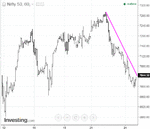dbphoenix
Guest Author
- Messages
- 6,954
- Likes
- 1,266
I entered at 7200 because the chart on 23rd, nifty opened high and did not even attempted to go up- continuously sliding which broke previous day low as well. So thats why I entered aggressively (this is something similar to price action method which I followed earlier).As you said, I too closed some and carrying few lots as swing still.
Let me stick with pure SLA from here...probably on hourly timeframe.
If you had followed the SLA, you would have traded the 15m as follows:
If you want to trade the hourly, that's fine, but the hourly isn't a time frame; it's a bar interval. Your time frame is the expanse of time within which you're trading. If you're trading an hourly bar, your timeframe will be determined by at least the daily chart. Otherwise you start focusing on the trees and ignore the forest.
You may decide at some point that the SLA is not for you. That's fine. It's not for everyone.
Db












